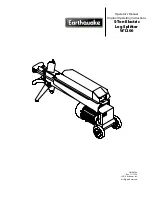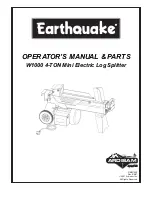
POSSIBLE FAULTS:
.................... ...........................................................................................
PROBLEM
POSSIBLE CAUSE
REMEDY
Motor stops starting.
Overload protection device disen-
gaged to protect the log splitter
from being damaged
Contact a qualified Electri-
cian.
Fails to split logs.
Log is improperly positioned.
Refer to
”operation” section
to perfect log loading.
Size of log exceeds the capacity of
the machine.
Reduce log size before oper-
ating.
Wedge cutting edge is blunt.
Sharpen cutting edge.
Oil leaks.
Locate leak(s) and contact
your dealer.
Log pusher moves jerkily,
taking unfamiliar noise or
vibrating a lot.
Lack of hydraulic oil and excessive
air in the hydraulic system.
Check oil level for possible re-
filling. Contact your dealer.
Oil leaks around the cylin-
der ram or
from other points.
Air sealed in hydraulic system
while operating.
Loosen bleed screw by some
rotations before operating
the log splitter.
Bleed screw is not tightened be-
fore moving the log splitter.
Tighten bleed screw up be-
fore moving the log splitter.
Oil drain bolt is not tight.
Tighten the oil drain bolt.
Hydraulic control valve assembly
and/or seal(s) worn.
Contact your dealer.
Jammed log:
WARNING!
- Do not allow someone else to help you with the release the jammed log.
- Do not try to knock the jammed log off. Knocking about will damage the machine or may launch
the log and cause accident.
1. Release both controls.
2. After the log pusher moves back and completely stops at its starting position, insert a wedge
wood under the jammed log.
3. Start the log splitter to push the wedge wood under the jammed one.
4. Repeat above procedure with sharper slope wedge woods until the log is completely freed.
ENVIROMENTAL PROTECTION:
.......................................................................................................
Do not dispose of electric tools together with household waste material! In
observance of European directive 2002/96/EC on wasted electrical and electronic
equipment and its implementation in accordance with national law, electric tools
that have reached the end of their life must be collected separately and returned to
an environmentally compatible recycling facility.




























